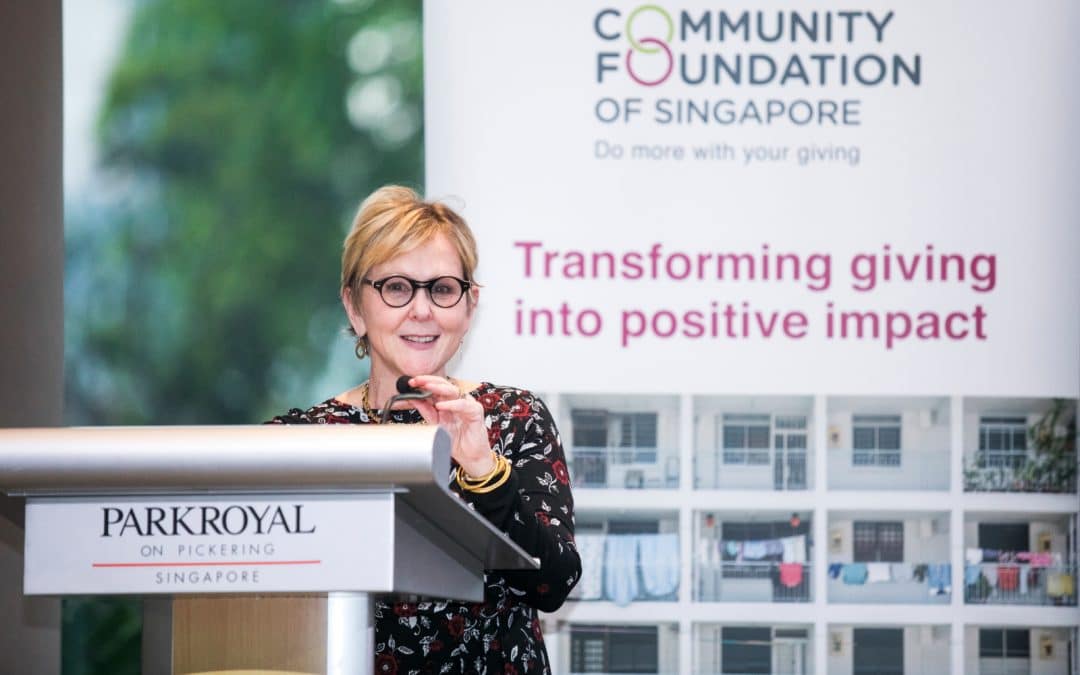Eileen Heisman: Donor advised funds are a flexible tool that can adapt to changing giving interests


(Excerpts from a keynote speech by Eileen Heisman, President and CEO, National Philanthropic Trust delivered at the CFS Philanthropy Forum 2019)
When I was here in Singapore a decade ago as part of the Community Foundation of Singapore’s (CFS) international advisory committee, the idea of being involved in the global launch of a community foundation was so exciting to me. Everyone here was really eager to learn. They wanted to have impact. I knew CFS was going to set its own path.
Over 22 years ago, I was sitting in a dark, private cubicle trying to figure out what to do with this brand new charity I was part of. Today, National Philanthropic Trust (NPT) – which is the largest independent donor advised fund (DAF) administrator in the United States – has raised US$13 billion in charitable contributions and currently manages US$7.4 billion in charitable assets. In recent years, we’ve started making global grants of around US$700 million to over 75 countries.
I see a lot of similarities between CFS’s journey and my time in that small cubicle. CFS has raised S$130 million and given away S$70 million. With this incredible talent, opportunity and resources you have here, I believe there’s so much more CFS can grow as a community foundation.
What compels a potential donor to act? I’ve spent a lot of time thinking about this question throughout my career working with donor advised funds. Just as every person comes to this earth with different gifts and backgrounds, donors have vastly different philanthropic goals. I’ve had the privilege of getting inside the thinking of donors and understanding what excites them about philanthropy. One of the biggest moments in my career at NPT was when a donor from New York City donated US$200 million to us. He was an early adopter and one of those people who saw opportunity.
I like to say donors don’t give to us, they give through us. Donor advised funds are flexible. They are relatively inexpensive. They can meet and adapt to changing interests. If you were interested in a cause when you were younger and that changes as you grow older, you’re not wedded to that particular cause because you can shape the fund according to your preferences. Philanthropy is also about legacy. A DAF is a tool you can spend down over your lifetime or you can pass it down to your children.
It’s one of the reasons why donor DAFs are the fastest growing philanthropic tool in the United States. The number of DAFs has doubled in the US over the last five years. In addition to Singapore, there is growing interest in DAFs in Asia, from China, India, Hong Kong to Japan. As a philanthropic tool, I believe DAFs are going to become more and more popular.
If I had to give a piece of advice to new donors: when you’re getting started with giving through DAFs, it’s important not to overcomplicate the process. Start simple. Find two or three causes you really like. Find one or two good charities in each of those categories, and support those charities over three to five years.
With any social issue, nothing gets solved within one year. In the social sector, we learn about solutions to existing problems from trying new things. Don’t be afraid to fund solutions that are new because it’s the only way we learn. It’s as important to fund failure as it is to fund success.
One of the wonderful things about being part of a community foundation is that it truly is a way to make the world a better place. Doing it with partners and the community’s collective effort makes the journey so much more enjoyable than doing it alone.
Eileen Heisman
President and CEO
National Philanthropic Trust
(Excerpts from a keynote speech by Eileen Heisman, President and CEO, National Philanthropic Trust delivered at the CFS Philanthropy Forum 2019)
When I was here in Singapore a decade ago as part of the Community Foundation of Singapore’s (CFS) international advisory committee, the idea of being involved in the global launch of a community foundation was so exciting to me. Everyone here was really eager to learn. They wanted to have impact. I knew CFS was going to set its own path.
Over 22 years ago, I was sitting in a dark, private cubicle trying to figure out what to do with this brand new charity I was part of. Today, National Philanthropic Trust (NPT) – which is the largest independent donor advised fund (DAF) administrator in the United States – has raised US$13 billion in charitable contributions and currently manages US$7.4 billion in charitable assets. In recent years, we’ve started making global grants of around US$700 million to over 75 countries.
I see a lot of similarities between CFS’s journey and my time in that small cubicle. CFS has raised S$130 million and given away S$70 million. With this incredible talent, opportunity and resources you have here, I believe there’s so much more CFS can grow as a community foundation.
What compels a potential donor to act? I’ve spent a lot of time thinking about this question throughout my career working with donor advised funds. Just as every person comes to this earth with different gifts and backgrounds, donors have vastly different philanthropic goals. I’ve had the privilege of getting inside the thinking of donors and understanding what excites them about philanthropy. One of the biggest moments in my career at NPT was when a donor from New York City donated US$200 million to us. He was an early adopter and one of those people who saw opportunity.
I like to say donors don’t give to us, they give through us. Donor advised funds are flexible. They are relatively inexpensive. They can meet and adapt to changing interests. If you were interested in a cause when you were younger and that changes as you grow older, you’re not wedded to that particular cause because you can shape the fund according to your preferences. Philanthropy is also about legacy. A DAF is a tool you can spend down over your lifetime or you can pass it down to your children.
It’s one of the reasons why donor DAFs are the fastest growing philanthropic tool in the United States. The number of DAFs has doubled in the US over the last five years. In addition to Singapore, there is growing interest in DAFs in Asia, from China, India, Hong Kong to Japan. As a philanthropic tool, I believe DAFs are going to become more and more popular.
If I had to give a piece of advice to new donors: when you’re getting started with giving through DAFs, it’s important not to overcomplicate the process. Start simple. Find two or three causes you really like. Find one or two good charities in each of those categories, and support those charities over three to five years.
With any social issue, nothing gets solved within one year. In the social sector, we learn about solutions to existing problems from trying new things. Don’t be afraid to fund solutions that are new because it’s the only way we learn. It’s as important to fund failure as it is to fund success.
One of the wonderful things about being part of a community foundation is that it truly is a way to make the world a better place. Doing it with partners and the community’s collective effort makes the journey so much more enjoyable than doing it alone.
Eileen Heisman
President and CEO
National Philanthropic Trust
- Related Topics For You: CHARITY STORIES, DONOR STORIES, DONOR-ADVISED FUND, EVENTS, OPINION



